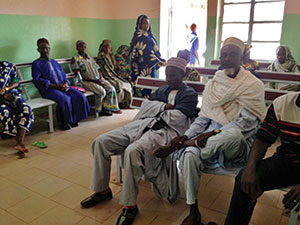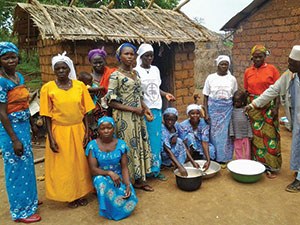Herman Fink, a member of Our Savior Lutheran Church in Corsica, S.D., said he has “no illusions of being an evangelist.” But for more than 20 years, Fink and others in the South Dakota Synod have shared the gospel through their ministry with people living almost 7,000 miles away.
In 1995, Fink was part of a mission trip to Cameroon to visit the Evangelical Lutheran Church in Cameroon, a companion of the South Dakota Synod. “This was the fastest growing mission field in the world,” he said. “The church was growing by leaps and bounds.”
During the trip they saw village churches being built from local materials such as rock and brick. But the buildings couldn’t be completed because roofing materials weren’t readily available and were too expensive to transport.
Fink returned to South Dakota with a mission in mind. “I’m a cowboy, a nuts and bolts guy,” he said.
Describing Fink’s involvement, David Zellmer, bishop of the South Dakota Synod, said, “He went on that first trip and was actually transformed by that whole thing. He came back and very much wanted to work on the relationship. So he brought a resolution the next year at the synod assembly that we would begin raising money for roofs and sending people over as soon as possible.”
Fink said, “It was something that caught the imagination of the people.”
Raising the roof with funds
Fundraising efforts took off in congregations throughout the synod, resulting in enough for four to six roofs each year. Members also traveled to Cameroon to help build the roofs, which cost approximately $8,000 each.
“Working with the local communities and worshiping together under those roofs with the vibrant local congregations has an amazing transformational power for those who become involved,” said Natanael Lizarazo, companion synod coordinator, who called them “joyful ambassadors and advocates for this mission project.”
The ministry continued to grow, yet fundraising for the roofs wasn’t happening as quickly as the churches were being built. By 2013 many churches were still waiting for roofs.
“We heard of churches that had been waiting seven or eight years for their roof … something was needed,” said Cathy Larson, former companion synod coordinator and a former ELCA missionary in Cameroon. “We were only doing about three or four a year, so at that rate it would take years and years.”

Both Christian and Muslim refugees received medical care at the Garoua-Boulai Protestant Hospital.
As the ELCA’s 25th anniversary approached, Larson had an idea that she first proposed in a Women of the ELCA synod newsletter. Inspired by the women’s organization’s incentive to “be bold,” she wondered if it would be possible to raise money for 25 roofs. “Wow, that’s like $200,000,” she remembered realizing. “Maybe we won’t, but maybe we will.”
Larson wrote a resolution, which Fink presented to the synod assembly in 2013. In December 2014, the fundraising goal of $200,000 was reached. Even with small offerings, everyone could do something. “I think you learn to give by giving,” Larson said. “I don’t think you can learn to give by any other way.”
Jean Abissi, bishop of the North Region of the Evangelical Lutheran Church in Cameroon, said, “The faithful find great joy in having their churches completed with the roofs. They are very thankful. It is a gesture of love which strengthens our relations.”
Unintended consequences
“My favorite part of the church is we sometimes make decisions that just have completely unintended consequences,” Zellmer said.
The roof project provided an important way for members like Fink to be in ministry with Lutherans across the globe. But the ministry didn’t stop with church roofs. It led to something bigger that helped transform the lives of thousands of refugees who arrived in Cameroon in 2013, fleeing violence in the region.
Zellmer said as the roof project grew in the synod, the ministry began to encompass a “broader perspective” to include faith communities in Canada, Norway, France and Germany. In 2011 the church bodies made a commitment to remodel two hospitals: the Ngaoundere Protestant Hospital in northern Cameroon and the Garoua Boulai Protestant Hospital in the country’s east province near the border with the Central African Republic.

As a result of the renovation, the Protestant Hospital was the only medical facility in Garoua-Boulai, Cameroon, able to provide care for injured refugees from the Central African Republic.
The Garoua Boulai hospital was started by Lutheran missionaries in 1953. Sixty years later, funds from ELCA World Hunger and the South Dakota Synod helped with hospital renovation. In 2013 the remodeled hospital celebrated its 60th anniversary.
“Thank God the renovations were done, otherwise we would not [have been] able to respond to the major flux of refugees from the Central African Republic in early 2014,” said Solofoniaina Rakotoarivelo, the hospital’s medical director. “The Protestant hospital was the only medical facility that was able to receive the wounded from the war [there]. We took care of both the Muslim and the Christian factions. The influx of refugees continued so the hospital was saturated with both Cameroonian and refugee patients.”
According to the U.N. High Commission on Refugees, Cameroon hosts the largest number of Central African refugees, with the majority arriving from the Central African Republic and Nigeria.
“It is amazing how God used our hospital to be the light for those refugees. The hospital was also the place of reconciliation of both communities, Muslim and Christian,” Rakotoarivelo said.
Zellmer added, “All of that got done because we had this idea that we would build 25 roofs. It’s the ripple effect.
Anne Ruedisili Langdji, ELCA representative for West Africa, said Garoua Boulai, once a town of about 12,000, is now home to a sizable refugee population. “Our assistance to the hospital came just at the right time for them as they needed to be able to respond to the needs of those people who had fled violence in the Central African Republic.”
Etienne Nganyi, a pastor of the Evangelical Lutheran Church in Cameroon, said, “I am so thankful, this is work that glorifies God. The support encourages us … and shows the joy we share; it shows love even when we don’t see one another. It is a blessing.”
Fink credits the Spirit. “I have no clue why [the Spirit] chose me,” he said, “but to have been a part of that for me was quite important because we did something useful. It’s been an awesome, awesome journey.”




